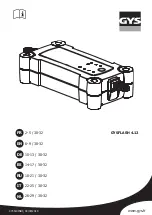
The warning vibration occurs earlier in the fol-
lowing situations if:
R
you approach the outer lane marking on a
bend
R
the road has very wide lanes, e.g. a motorway
R
the system detects solid lane markings
The warning vibration occurs later in the follow-
ing situations if:
R
the road has narrow lanes
R
you cut the corner on a bend
Towing a trailer
Important safety notes
G
WARNING
You could lose control of the vehicle/trailer
combination if it begins to swerve. The vehi-
cle/trailer combination could even overturn.
There is a risk of an accident.
On no account should you attempt to
straighten out the vehicle/trailer combina-
tion by increasing speed. Decrease your
speed and do not countersteer. Brake if nec-
essary.
G
WARNING
If the maximum permissible load for a carrier
system is exceeded, the carrier could come
loose from the vehicle and endanger other
road users. There is a risk of an accident and
injury.
Never exceed the maximum permissible load
when using a carrier.
!
If you have a trailer tow hitch retrofitted,
changes to the engine cooling system may be
necessary, depending on the vehicle type.
If you have a trailer tow hitch retrofitted,
observe the anchorage points on the chassis.
Retrofitting a trailer tow hitch is only permissible
if a trailer load is specified in your vehicle docu-
ments. If this is not the case, then the vehicle is
not approved for towing a trailer.
For more information, please contact a qualified
specialist workshop.
Exceeding the maximum permissible nose-
weight of the trailer drawbar on the ball coupling
may cause damage to the following:
R
your vehicle
R
trailer
R
ball coupling
R
trailer tow hitch
The vehicle/trailer combination could become
unstable.
The vehicle/trailer combination could also
become unstable if the noseweight used is lower
than the minimum permissible noseweight.
To avoid hazardous situations:
R
make sure to check the noseweight before
each journey
R
the noseweight should be as close as possible
to the maximum noseweight
R
do not exceed the maximum permissible
noseweight
R
the noseweight must not be lower than the
minimum permissible noseweight
Make sure that the following values are not
exceeded:
R
the permissible noseweight
R
the permissible trailer load
R
the permissible rear axle load of the towing
vehicle
R
the maximum permissible gross vehicle
weight of both the towing vehicle and the
trailer
The applicable permissible values, which must
not be exceeded, can be found:
R
in your vehicle documents
R
on the identification plates of the trailer tow
hitch and the trailer
R
on the vehicle identification plate
If the values differ, the lowest value applies.
You will find the values approved by the manu-
facturer on the identification plates and for the
towing vehicle under "Technical data"
(
Y
page 359).
G
WARNING
If you release the ball coupling or it does not
engage correctly when folding in, it will swing
out. Within pivoting range of the ball coupling,
there is an increased risk of an accident and
injury.
212
Towing a trailer
Driving
and
parking
















































